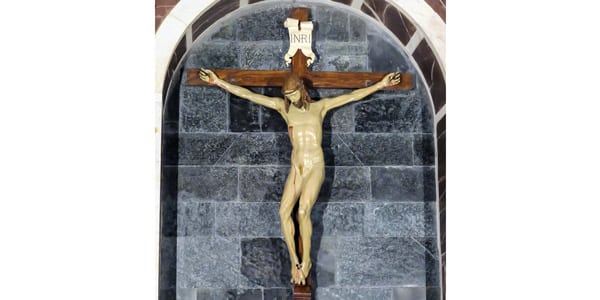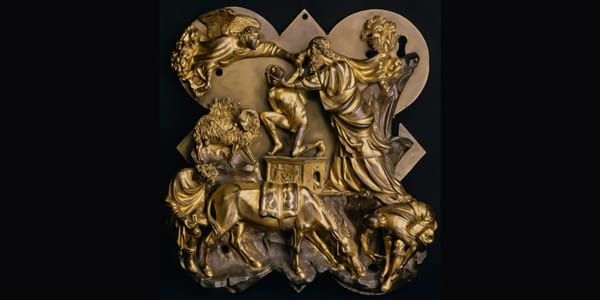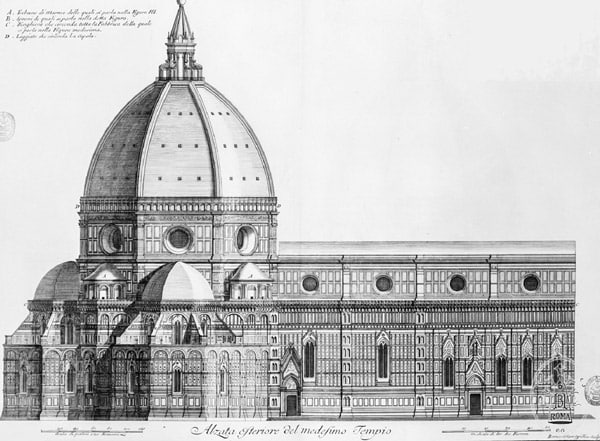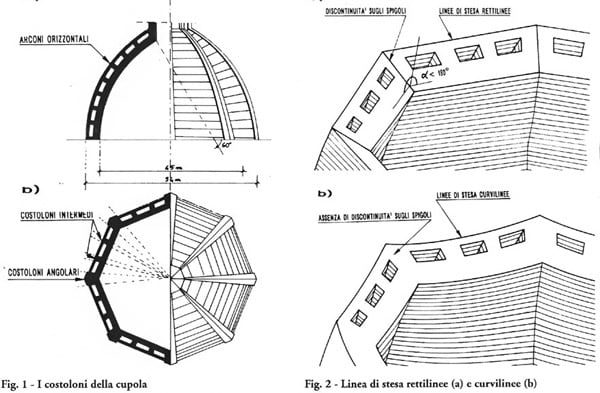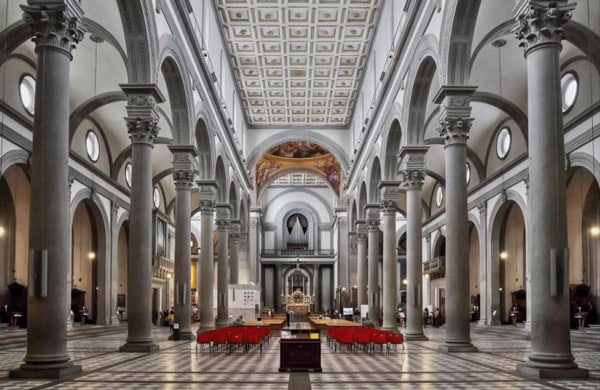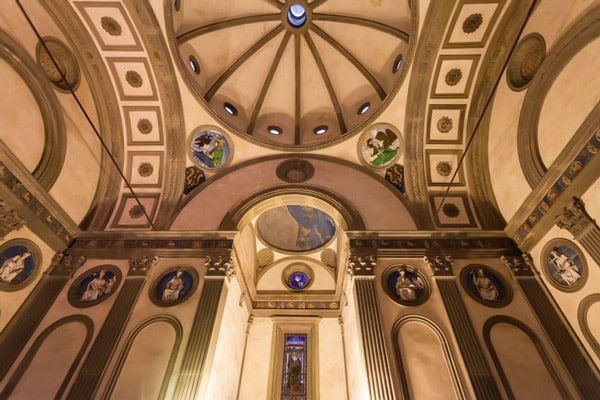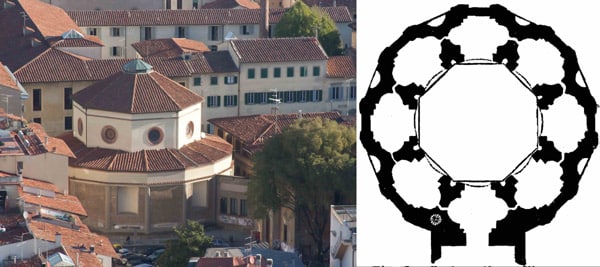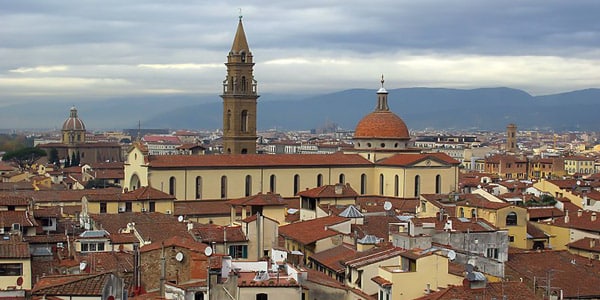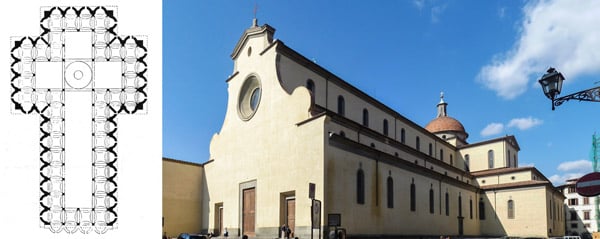The architect, sculptor, inventor and scientist Filippo Brunelleschi was a true innovator and genius of his time. He made an invaluable contribution to the cultural heritage not only of Italy, but also of the world. The unique look of Florence was created in many ways thanks to Brunelleschi’s architectural masterpieces. Travellers to Florence should not miss out on the master’s great works and the chance to experience the high art of the Early Renaissance.
Page Contents
Biography
The future great creator was born in 1377. Unlike other Florentine artists he came from not a simple family of craftsmen.
As was proper for the children of wealthy families, Filippo received a brilliant liberal education. From an early age he studied Latin, literature, and theology. The young man showed a remarkable talent for the exact sciences, diligently studying arithmetic, geometry and physics, later surprising the famous scientist Paolo dal Pozzo Toscanelli with his knowledge. At a young age versatile Filippo was fond of painting, and at the same time designed and made all kinds of gadgets and technical innovations.
The love of creativity has defined the way of life Brunelleschi, who decided to devote himself to the jewelry business, which in the Middle Ages was closely associated with the art of sculpture and architecture.
During his training he practiced drawing, modelling and engraving and studied with the famous goldsmith Linardo di Matteo Ducci in Pistoia and quickly excelled in his chosen profession. In 1398 he became a member of the Florentine Art Guild, Arte della Seta. In 1402, he went to Rome, where he studied the principles and peculiarities of ancient structures for several years.
Returning to his native city, Filippo Brunelleschi quickly won great prestige and respect from the citizens of Florence. For many years he was entrusted with the function of chief architect, planning the urban environment and carrying out important government commissions.
Creator of the scientific theory of perspective
Despite the fact that documentary evidence of Brunelleschi’s theoretical developments and discoveries has not survived, he is credited with the authorship of the idea of direct perspective. Thanks to his innovative view of the art of the masters of the XV century and subsequent centuries opened the way to transfer the depth of space and the outer volume.
In his theoretical studies Filippo Brunelleschi, relying on the achievements of the ancient creators and known to him theses of engineering sciences, collected into a single system disparate concepts of linear perspective. He derived the laws of three dimensions, symmetry and proportion, which apply both to painting and architecture. For the latter, their use was especially important, as it allows you to create a volumetric image of the buildings, to take into account all the features and complexities of construction, before construction work.
Without knowledge of perspective impossible work of modern artists, sculptors, architects and engineers.
Sculptural work
The creation of sculptural works belongs to the early stage of Brunelleschi’s work. Not all of his creations were preserved. For example, the statue of Mary Magdalene, made of wood to adorn the church of Santo Spirito (basilica di Santa Maria del Santo Spirito), was burned in a terrible fire in 1471.
The Crucifixion in the Basilica di Santa Maria Novella, dating from about 1410, deserves particular attention.
The sensual, exquisite figure of the Savior is said to have been the result of a creative dispute with Brunelleschi’s best friend, Donatello.
The most famous sculptural creation is the bronze relief of the Sacrifice of Isaac (1401), made for a competition of artists competing to decorate the doors of the Baptistery of San Giovanni (battistero di San Giovanni).
The work is distinguished by its originality, realism, and the freedom of composition. Although Filippo did not win the competition, the bronze relief was considered a work worthy of the highest praise. Art lovers can see it in the Museo nazionale del Bargello in Florence.
The most famous architectural works
The most famous architectural creations by master Filippo Brunelleschi are, of course, in Florence.
The Cupola del Brunelleschi
The main work of the master in Florence, which brought him incredible fame is the dome of the Cathedral of Santa Maria del Fiore (la Cattedrale di Santa Maria del Fiore).
This monumental creation embodies an ingenious engineering idea: with the gigantic size of the octahedral construction (its height is 90 meters) they managed to create lightness, harmony, simplicity and clarity of form. Construction of the dome began in 1420 and was completed 14 years later. During the unprecedented construction, the young architect, who had no previous experience of such large objects, invented and implemented some unique techniques, which ensured stability and reliability of the structure:
- The curvature of the angle of the ribs corresponded to 60 degrees, and the level of the slope was maintained thanks to wooden mouldings moving upward as new rows of masonry appeared;
- The brickwork was not laid horizontally but with an inward slope (according to the Roman method) which eased the internal expansion and reduced the load on the building foundation;
- The bricks were arranged in a herringbone pattern which obviated the need to use tourniquets (special arched boards for constructing vaults of stone);
- The dome consisted of two shells, with the inner one playing the role of a strong frame made of reinforcement woven into the masonry, and the outer one performing a protective and decorative function.
Moreover, the architect had developed special mechanisms with gears, facilitating the lifting of multi-ton building materials to great heights. Brunelleschi carefully thought out the smallest details and auxiliary devices. He designed a system of drains, internal staircases and passageways. He is credited with the drawings of the edicule lantern with semicircular protrusions, which crowned the structure.
The white marble structure at the top of the dome was completed after his death under the direction of Antonio Manetti and Bernardo Rossellino.
Brunelleschi’s dome is considered not just one of the most popular landmarks, but the main architectural symbol of Florence. Every day thousands of tourists climb its observation deck, climbing more than 460 steps, and enjoy a bird’s eye view of the magnificent panoramic view.
The House of Education
In parallel with his work on the dome of the Duomo, Brunelleschi supervised the design and construction of other structures, such as the Ospedale degli Innocenti – the Orphanage for Parents Left Behind. It was to have rooms for infants, classrooms and craft workshops to enable the children to acquire a profession.
Construction work began in 1419 and, due to lack of funding, was not completed until 1445, when Brunelleschi’s pupil Francesco Della Luna was involved.
The stylistics of the building and of the Loggia had an enormous influence on the development of not only Italian but also world culture, becoming a model of Early Renaissance architecture. The concept was based on innovative ideas born of motifs of Roman, Gothic and Romanesque architecture.
The façade of the first floor of the 70-meter building is an airy arcade supported by graceful Corinthian columns made of dark gray stone. This unusual color effect, which gives the structure a dynamic and rhythmic effect, was subsequently often borrowed by Florentine architects. The coherence of the composition is given by the wide staircase which connects the building with the spacious courtyard. The side spans without arcades give rise to a feeling of monumentality and solidity.
The Ospedale degli Innocenti is located in Piazza della Santissima Annunziata, in the historic center of Florence. For several centuries a charitable institution has continued to function within the walls of the building. In addition to the art museum today there are women’s and children’s shelters, a nursery and a maternity school. A visit to the Orphanage is included in many excursion programs and causes much interest and excitement among tourists.
We advise you to read: how to spend 3 days in Florence
The Sacristy in the Basilica of San Lorenzo
The Basilica di San Lorenzo, historic church of Florence, dating back to 393, at the time of St. Ambrose of Mediolano, was renewed and rebuilt in the XI century.
In the process of reconstruction the basilica acquired Romanesque style of architecture without losing the early Byzantine architectural ideas. At the beginning of the XV century the city authorities decided to make another reconstruction of the dilapidated temple, which at that time had no dome and consisted of three small naves.
Filippo Brunelleschi worked on the reconstruction project. The architect built a sacristy and also thought of ways to enlarge the space of the building by designing the layout in the form of a Latin cross. He designed models and sketches of family chapels for the Medici clan, the dome of the basilica, and options for interior and exterior wall decoration. By 1429 a large part of the work had been completed, but not entirely due to the sudden death of Giovanni di Bicci de’ Medici, commissioner of the project. A further reconstruction was carried out some years later, under the direction of another architect, Michelozzo di Bartolomeo, who slightly modified Brunelleschi’s creative intentions.
The Pazzi Chapel
The Cappella dei Pazzi in the Basilica di Santa Croce, named after the nobleman of Florence, Andrea de Pazzi, is one of Brunelleschi’s most graceful and beautiful creations.
Design and construction work began in 1429 and ended decades later, after Brunelleschi’s death. Brunelleschi had the difficult task of fitting the chapel into the architectural ensemble of a medieval basilica and placing it on a complex site. The result is an amazingly light and airy structure, sharply different in its stylistics from traditional Roman and Gothic constructions.
Church of Santa Maria degli Angeli
The oratory of Santa Maria degli Angeli is Brunelleschi’s next major work of ecclesiastical architecture, which unfortunately he was unable to complete.
A model of the building was created in 1434. The architect readily began work, but three years later construction had to be halted due to lack of funds and the outbreak of war between Lucca and Florence. Brunelleschi erected only 4.5 meters high walls. According to some historians copies of drawings of the great master have survived. In the XVIII-XIX centuries there were repeated attempts to reconstruct the church building. The last reconstruction took place in the 30s-40s of the last century.
The lower part of the construction as much as possible corresponds to the original architectural plans of Brunelleschi. It is based on a play of geometric forms: the 8-sided interior is in harmony with the 16-sided design of the facade walls decorated with alternating deep niches and windows. All these techniques create a clear and elegant plan, giving rise to a sense of rhythm and dynamism.
Church of Santo Spirito
The present building of the Basilica di Santa Maria del Santo Spirito is a true symbol of the Early Renaissance.
The old temple was built on the site of an ancient monastery dating back to the XIII century. After a devastating fire that occurred in the XV century, it was decided to reconstruct it globally. The author of the drawings and models of the new church belongs to Brunelleschi. According to the architect’s plan, the frontal part of the building should look at the Arno River, but the dense residential buildings and narrow streets did not allow to realize this plan. The master began his work in 1436, and the basilica was completed 18 years later, after his death, with the participation of Antonio Manetti and other pupils of Brunelleschi.
The layout of the building is in the form of a Latin cross. A sense of volume and integrity is created by the semicircular niches along the perimeter of the building instead of the rectangular side chapels. Rhythmical alternation of colonnades and arched arches promotes dynamics, architectural saturation, gives rise to depth and visual expansion of space.
Next to the basilica is an inexpensive and delicious restaurant Osteria Santa Spirito, take note.
Features of the architectural style
Unfortunately, Brunelleschi did not manage to complete all his works, but each project of the creator immortalized his name, becoming an example of early Renaissance architecture, organically combining medieval traditions and classical elements.
The best of Florence’s masters passed away in 1446, at the venerable age of 69. His work, combining monumentality and poetic elegance, high art and scientific validity of ideas, opened a new era and identified a vector of development of architecture of the Early Renaissance. Brunelleschi style is distinguished by a clear logic of the compositional solution and harmony of the visual appearance. The system of proportions, the perfect severity of the geometric forms, the use of linear perspective, attention to detail and small decorative elements – all these revolutionary for the Middle Ages techniques gave rise to new standards of beauty in art.
 Italy for me From Italy with love
Italy for me From Italy with love


